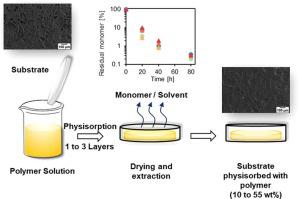European Polymer Journal ( IF 6 ) Pub Date : 2021-09-02 , DOI: 10.1016/j.eurpolymj.2021.110748 Victor D. Lechuga-Islas 1, 2 , Melisa Trejo-Maldonado 1, 2 , Steffi Stumpf 1, 3 , Ramiro Guerrero-Santos 2 , Luis Elizalde-Herrera 2 , Ulrich S. Schubert 1, 3 , Carlos Guerrero-Sanchez 1, 3

|
After synthesis, specialty polymers can be difficult to purify from residual volatile monomers and solvents in a precise and reproducible manner using current standard separation techniques, which also generate large amounts of waste. Herein, we report a proof-of-principle study of a cost-effective and versatile method for separating residual volatile compounds from synthetic polymers via physisorption (i.e., polymer purification by physisorption (3P)). Model polymers were used to evaluate the capabilities and advantages of the 3P method over standard purification techniques regarding separation of volatile compounds, process solvent to polymer yield, and final properties of the resulting polymers. Compared to dialysis and precipitation, the 3P method could separate up to 99% of the residual monomer from a polymerization reaction using a significantly lower fraction of solvent. Unlike the benchmark methods, the molar mass and dispersity of polymers purified by the 3P process remain practically unaffected; polymers were quantitatively recovered for subsequent applications (e.g., precursors for block copolymer synthesis or characterization purposes). The 3P method represents a straightforward technique for polymer purification and is suitable for automation, which will help to overcome the unsolved and labor-intensive task of purifying (co)polymer libraries derived from high-throughput experimentation.
中文翻译:

通过物理吸附从聚合物中分离挥发性化合物
合成后,使用当前的标准分离技术很难以精确和可重现的方式从残留的挥发性单体和溶剂中纯化特种聚合物,这也会产生大量废物。在此,我们报告了一种通过物理吸附从合成聚合物中分离残留挥发性化合物的经济高效且通用的方法(即,通过物理吸附 (3P) 纯化聚合物)。模型聚合物用于评估 3P 方法相对于标准纯化技术的能力和优势,涉及挥发性化合物的分离、工艺溶剂与聚合物的产率以及所得聚合物的最终性能。与透析和沉淀相比,3P 方法可以使用显着更低的溶剂比例从聚合反应中分离出高达 99% 的残留单体。与基准方法不同,通过 3P 工艺纯化的聚合物的摩尔质量和分散性实际上不受影响;聚合物被定量回收用于后续应用(例如,用于嵌段共聚物合成或表征目的的前体)。3P 方法代表了一种简单的聚合物纯化技术,适用于自动化,这将有助于克服未解决的劳动密集型任务,即纯化源自高通量实验的(共)聚合物库。



























 京公网安备 11010802027423号
京公网安备 11010802027423号